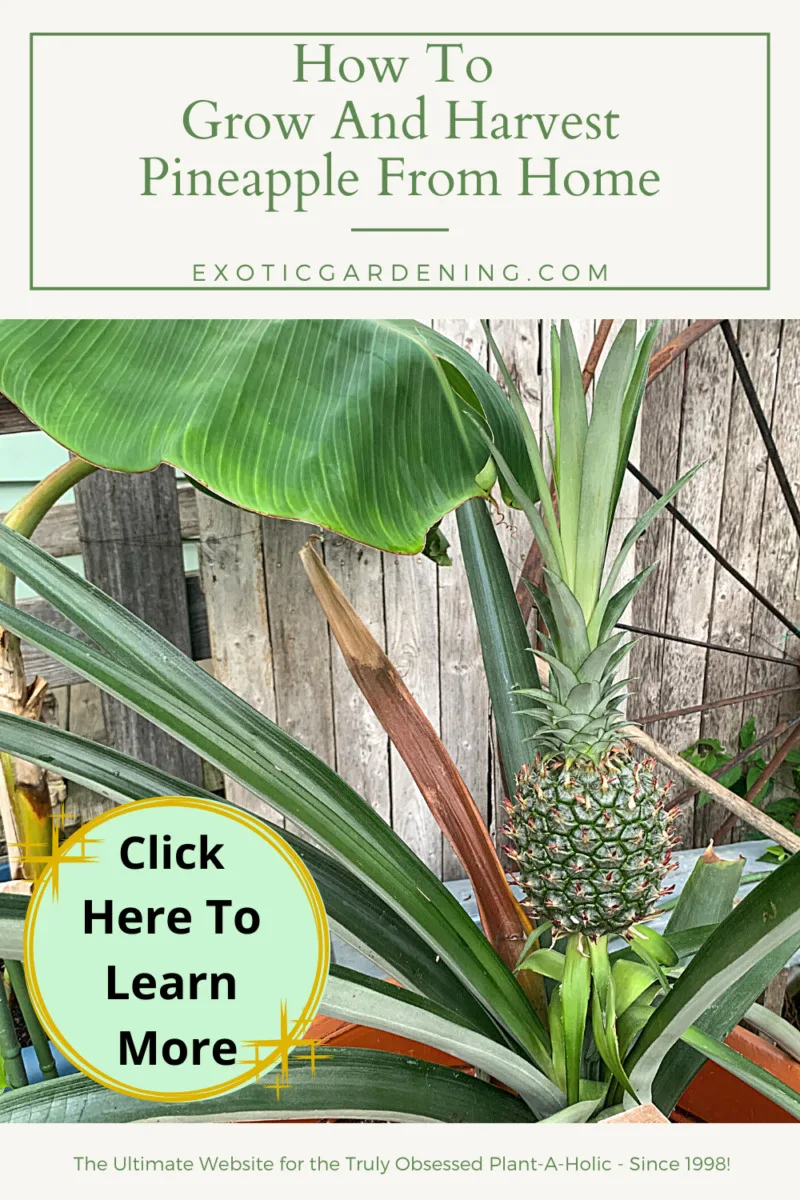Pineapples are a tropical fruit native to South America but you can grow and harvest pineapple no matter where you live.
Pineapples have been cultivated and grown for a number of years in the region of Brazil, however these exotic fruits make great houseplants.
Even in cold climates it is possible to get these plants to set fruit and ripen indoors.
People who see your pineapple growing will be impressed, but once you get a taste of a homegrown pineapple you won't want store bought anymore.

Introduction to Growing Pineapples
Store-bought fruit does not compare in taste or sweetness to a pineapple you grew yourself.
One reason for this is because the store bought pineapples were picked before they were fully ripe, unlike one you would grow in your home or yard that would be left on the plant until it was fully ripe and ready to eat.
There are many varieties of pineapple plants.
Some are ornamental and some are edible.
The various types are sorted by class.
There are four classes, according to Purdue University, 'Smooth Cayenne', 'Red Spanish', 'Queen', and 'Abacaxi.'
Once the plants are two years old, they will flower, then set fruit.
From the time the pineapple flowers to the time the fruit ripens on the plant takes six months, according to the pineapple research institute of Hawaii.

Pineapple Plant Care Tips for the Home Gardener
Below are some useful tips for pineapple plant care.
These tips are very easy to follow and will help you grow a healthy pineapple plant.
Pineapple plants require moderate sunlight and should be planted in an area with plenty of room for the plant to grow.
This means that they need just enough sunlight but not too much so it doesn't burn the leaves or fruit.
It also means that you should have enough room for the pineapple plant to grow because they can grow up to six feet tall.
When the pineapple plant is in active growth if it is being grown indoors, grow lights should be left on 12 to 14 hours per day.
Once your plant is old enough to set fruit, the pineapple research institute of Hawaii says that the light requirements change.
In nature, pineapples need 10 to 11 hours of sunlight daily to set fruit.
The short days and cool nights are what trigger the plants to bloom, according the pineapple research institute of Hawaii.
Plants grown with higher temperatures or given longer periods of light may not flower on time or the fruit maturation may be delayed.
It is also important that your pineapple plants live in a temperature controlled environment if you live in a cold place where they cannot live outside year round.
Be sure to plant your pineapple plant in rich organic soil and top the soil off with three inches of compost or mulch.
For pineapple fruit to mature in six months, a temperature range of 55 degrees Fahrenheit to 65 degrees Fahrenheit, must be maintained according to the Pineapple Research Institute of Hawaii.
Pineapple grown in cooler conditions produces fruit that tastes more acidic, and the fruits take longer to mature according to Purdue University.
Water weekly making sure to soak the soil and use a time release fertilizer.
Pineapple Flowering, Fruit Development, and Harvesting Requirements
Pineapple is a perennial plant that grows in tropical and subtropical climates.
It takes about 2 years to produce fruit, and 3 years to mature enough to be harvested.
The pineapple plant flowers year-round, but the flowering is not as heavy during some parts of the year.
The peak season for flowering is from December 1st through April 30th.
The development of the pineapple fruit depends on how much light it receives and when it was planted in relation to the date of planting.
If the plant was planted too early or too late during a particular planting season, then when it's mature enough to produce fruit it will usually offer much smaller harvests than if they were planted at the right time for that particular planting season.
The proper time for harvesting can be difficult to judge, according to Purdue University, even though the approximate time to harvest will be six months.
This is not a hard and fast rule, so look at your pineapple and note the changes.
These changes will signal proper harvesting time.
The pineapple shell, which is the part you see, will change color from green to gold.
When one half of the shell is changed, you can harvest it, but the longer you wait to harvest your pineapple, the sweeter it will be.
Inside the pineapple, the white flesh is changing to yellow.
How to Store Your Pineapples Until Ready to Eat
When you get your pineapple home, it is important to store it correctly.
The best way to store your ripe pineapple is at room temperature until it is cut into.
Your pineapple will last for approximately three days at room temperature.
Once it is cut into and the flesh has been peeled and chopped, go ahead and store it in an airtight container in the refrigerator.
When you are ready, you can eat the fruit fresh or use it in recipes.
You can also can pineapple, but be sure to use an up to date recipe, then store the jars of pineapple in a cool, dark place.
Pineapple can be cooked in different ways, such as boiling, baking, sauteing, or grilling.
It can also be eaten fresh in salads.
Pineapple is used to make a number of dishes that vary from all sorts of sweet dishes to savory dishes and drinks.

Conclusion: Growing and Harvesting a Homegrown Pineapple is More Than Worth It
Growing and harvesting a homegrown pineapple is more than worth it.
Pineapples are delicious, and many people enjoy the taste of this fruit.
But not everyone knows that there is an even greater, more fulfilling experience to be had in the process of growing one.
Growing a pineapple from scratch will take more time than you might think.
It can take up to two years before you can harvest your own pineapple from your plant, but it is well worth the wait!
Tropical Fruit And Foliage Plants
Tropical Plants For Medium To High Light
Check out these awesome tropcial plants for medium to high light that make wonderful, easy to care for houseplants.
Caring for Indoor Palm Plants: Tips for Thriving Green Beauties
Discover expert tips for caring for indoor palm plants, ensuring their vitality and adding a touch of tropical elegance to your space.
How To Grow Cinnamon
Learn how to grow cinnamon from seed or cuttings. Cinnamon trees do well as houseplants even though they can get rather large.
Colorful Foliage Plants
Try these colorful foliage plants in your garden this summer and then bring them indoors during the winter to brighten up your home decor.
Easy Exotic Houseplants: Tropicals That Thrive Indoors in Containers
Tropical plants are the most beautiful, easy to grow indoor houseplants. Start growing exotic houseplants today that fruit and flower!
Eucalyptus Growing Indoors: Tips and Troubleshooting Guide
Discover the art of eucalyptus growing indoors for year-round beauty and fragrant cut foliage in your flower arrangements.
My Theobroma cacao Story
I've had a love affair with growing chocolate for over twenty years, so I wanted to share my Theobroma cacao story with all of you.
Scented Grass Adds Natural Fragrance To The Home Or Garden
Scented grass is one way to add scent to your garden or even your home. Best of all, they look pretty, smell great and have practical uses.
Learning About Bananas
Once you start learning about bananas you may find this popular and important fruit is really quite fascinating and makes a great houseplant.
The Enigmatic Elegance: A Comprehensive Guide to Philodendron Florida Ghost Care
Elevate your indoor gardening with our guide to Philodendron Florida Ghost care, propagation, and maintenance tips.
Incorporating Bold And Exotic Plants Into Your Landscape
Discover the allure of bold and exotic plants for your garden in this comprehensive guide. Transform your landscape today!
Variegated And Other Interesting Plants: Elevate Your Space with Nature's Painted Wonders
Explore the world of variegated and unique plants, adding vibrant beauty and intrigue to your indoor oasis.
How To Grow Tropical Plants
Growing tropical plants - also known as houseplants - indoors is fun and enjoyable plus many of them clean the indoor of pollutants.
It is easy to grow exotic looking plants that produce tropical fruit and colorful flowers in a pot in your living room or office.
Many of these plants are easy to start from seed and I share with you five plants that I recommend for indoor growing.
I also share with you why growing your own tropical fruit saves money.
In this video you will learn:
How to bring tropical plants indoors at the end of summer
How to grow tropical plants indoors
How to protect and overwinter tropical plants outdoors in cold climates
How to propagate tropical plants
How to water tropcial plants
How to grow topical plants in a greenhouse

















